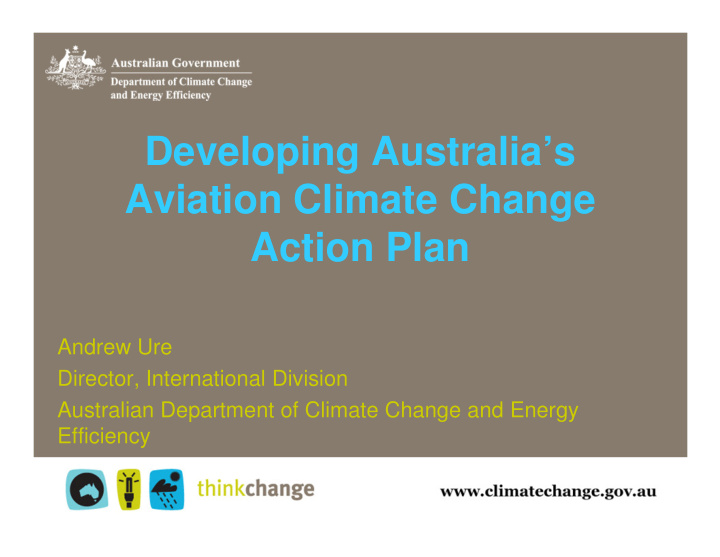



Developing Australia’s Aviation Climate Change Action Plan Andrew Ure Director, International Division Australian Department of Climate Change and Energy Efficiency
Overview of Australia’s Action Plan � Suite of strategies to address emissions from international and domestic aviation � Encompasses measures to reduce emissions from aircraft operations and within airport boundaries � ICAO’s goal - 2% annual average fuel efficiency improvement � Baseline: Emissions data available from 1990 Domestic fuel efficiency data from 1990 Domestic fuel efficiency data from 1990 International fuel efficiency data from 2008-09 Track emissions from a base year � Action structured around responsibilities of implementation bodies: AirServices Australia, airlines, airports, government and air traveller � Quantification of potential CO2 savings where possible
Australian Government Initiatives � Committed to economy-wide emissions reduction targets of at least 5% by 2020 and 60% by 2050 below 2000 levels. � Proposes to set a fixed domestic carbon price from 1 July 2012 as an interim measure until a full emissions trading scheme can be introduced in 3 − 5 years � Targeted assistance for the development of new biofuel technologies � Alternative Transport Fuels Strategy � National Carbon Offset Standard from 1 July 2010 � Development of carbon footprinting tools
Air Traffic Management Measures � Australia operating at maximum ATM operational efficiency of 98-99%. Future challenge: maintain peak performance with growth in air traffic. � Ongoing ATM procedures to improve aircraft operational efficiency � Flextracks – flexible routes optimised for prevailing weather (saves ~3.4 tonnes CO 2 per flight from the Middle East to Australia) 2 � RNP approaches and departures (saves ~403 kg CO 2 per approach) � Gate-to-gate management (saves ~600 kg CO 2 per Melbourne-Sydney flight) � International collaboration – ASPIRE (saves ~18 tonnes CO 2 per flight across the Pacific) � Airservices Australia is employing the use of the Air Traffic and Operations Management Simulator (ATOMS) to quantify potential benefits of individual ATM procedures
Airline Emissions Reduction Measures � Fleet renewal � Weight reduction measures � Improving load factors � Voluntary offsets for air passengers � Voluntary offsets by airlines
Airport Initiatives � More efficient use of ground support equipment � Reducing the use of APUs � Solar panels � Solar-powered airfield lighting � Improved energy efficiency in airport buildings � Land transport linkages � Land transport linkages
Alternative Aviation Fuels � Sustainable Aviation Fuel Road Map for Australia and New Zealand – May 2011 � Australian Government Alternative Transport Fuels Strategy – Sep 2011 � Commitment to establish an Australian Biofuels Research Institute � Qantas in joint ventures with Solena and Solazyme to develop “drop-in” alternative jet fuels � Microalgal biofuel projects at Australian universities – Adelaide University and James Cook University � Challenges: (1) Commercialisation (2) Competition from other transport sectors for alternative fuels
Next Steps � Liaise with key industry players to develop Australia’s Action Plan. � Quantify potential gains for individual measures where possible Thank You
Australia’s aviation emissions, 1989-90 to 2008-09 16 Domestic International 14 Total 12 issions (Mt CO 2 -e) 10 8 Aviation Emissio 6 Thank You 4 2 0 1990 1991 1992 1993 1994 1995 1996 1997 1998 1999 2000 2001 2002 2003 2004 2005 2006 2007 2008 2009 Financial Year Back
Australia’s annual domestic aviation emissions, 1989-90 to 2008-09 Australia's aviation emissions from domestic aircraft operations 7 29 Domestic Aviation Emissions tensity (kgCO 2 -e per 100 RPK) Domestic Aviation Emissions Intensity 6 26 missions (Mt CO 2 -e) 5 23 4 20 Aviation Emissions Inte Aviation Em 3 3 17 17 Thank You 2 14 1 11 0 8 1990 1991 1992 1993 1994 1995 1996 1997 1998 1999 2000 2001 2002 2003 2004 2005 2006 2007 2008 2009 Financial Year Back
Australia’s international aviation emissions, 2008-09 and 2009-10 Back
Recommend
More recommend